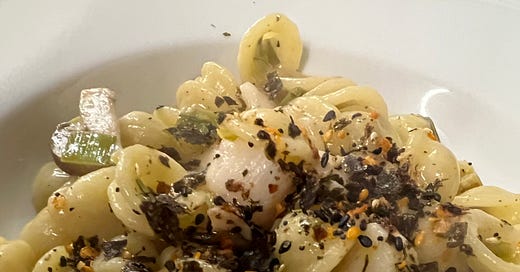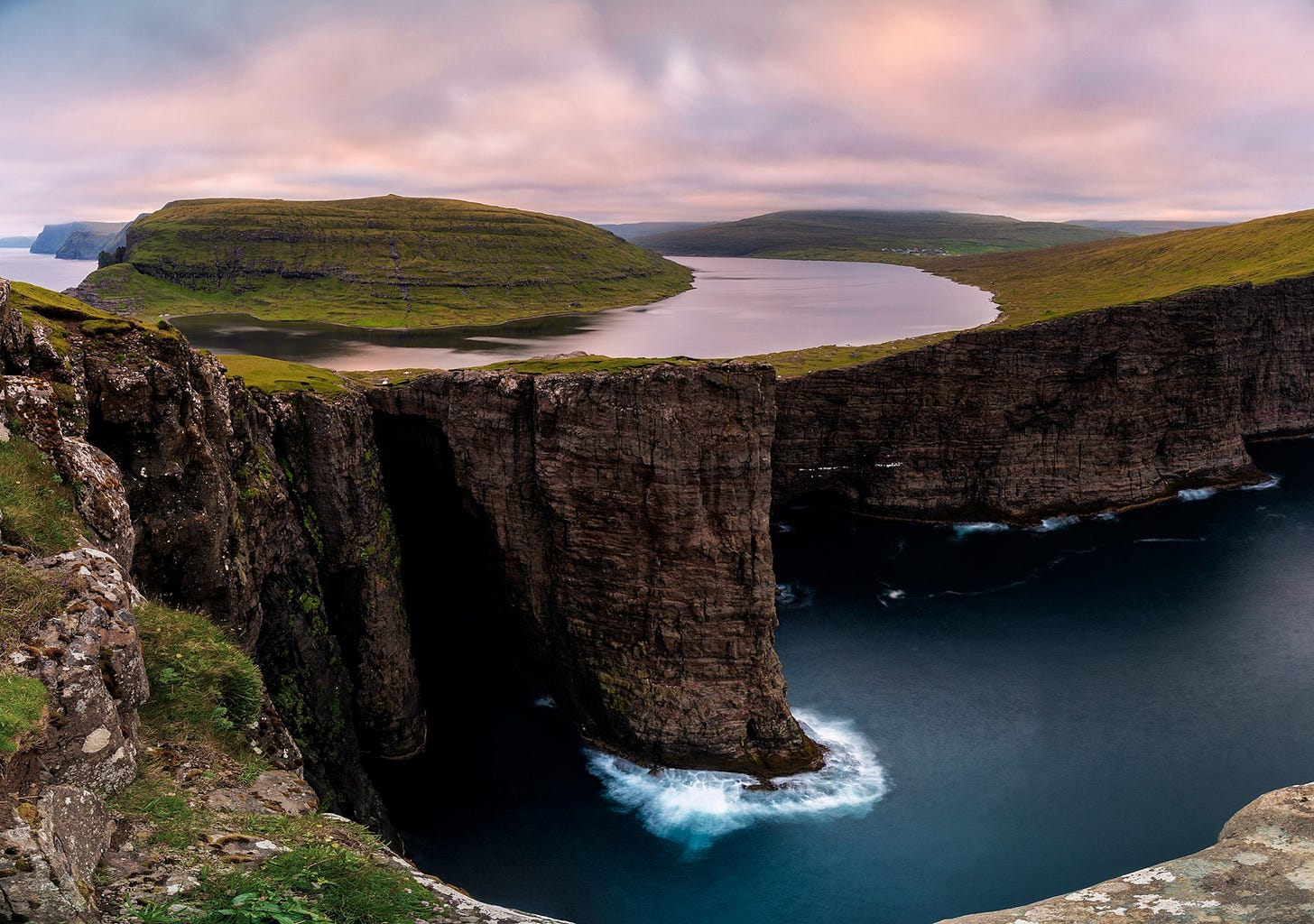Issue #192: Orecchiette with Bay Scallops and Melted Leeks
Home Again, A Quick Meal, Frozen Seafood, Pasta Is Comfort Food
What do you crave when you return from a long trip?
Is it selfish of me to say I crave my own cooking? It’s not any one dish or flavor that I miss. Rather, a combination of being in the kitchen, cooking for myself—Nate, too—and a type of caring that satisfies.
There are some things that make my own food feel healthier to me than most of what I consume when I’m away. I buy very good ingredients, especially fats—expensive extra-virgin olive oil, green peanut oil, butter made from grass-fed cows—and I don’t use that much of them (their expense fosters restraint). I don’t add sugar to everything. I emphasize whole grains and vegetables. I use only natural MSG, usually in the form of fermented pastes, liquids, or kelp, which I steep into water to make a dashi I substitute for stock. I may be crazy to think that my body can sense a difference in just a couple of weeks away from home. But my mind does.
I just got back after two weeks on the road. And the first thing I made was this scallop pasta with melted leeks. Why pasta? Because I love noodles. I always have multiple varieties, shapes, and sizes from different cultures in my cupboard. Pasta is usually the first thing I turn to. With just a couple of pantry items or a long-lasting leek left in the bottom of the produce drawer, you can have a filling, comforting, delicious dinner in minutes.
Frozen
Culturally, we have a bias against frozen seafood. This is funny to me because in Japan, arguably the culture that most cherishes delicacies from the sea, much of the seafood consumed has been frozen first, even some of the finest specimens of fish served in the best sushi joints. Sure, the Japanese are likely paying more attention as they move their seafood across the cold chain from shore to store than their American counterparts. But when done right, frozen seafood can be much better quality than poorly handled fresh.
A few weeks ago, in a grocery store up the way from us, I spotted a bag of IQF (Individually Quick Frozen) wild-caught bay scallops from the Faroe Islands. If you’ve been paying attention to global gastronomy over the last decade or two, you know the Faroe Islands enjoy mythical status in the imagination of chefs thanks to Noma’s Rene Redzepi and the New Nordic cuisine he has championed. I’ve never been myself, but many of my friends have traveled the chilly waterways of this Danish archipelago whence come some of the freshest, sweetest seafood. I bought the scallops and stuck them in the freezer for a night when Nate wasn’t home for dinner. (He doesn’t love seafood.)
Last Saturday, after being gone for two weeks, I got home around 6:30 pm. Nate was away on a business trip. I scrounged around in the fridge to figure out what to make myself for dinner. I found that old leek, a couple of shriveled mushrooms, some white wine. Then I remembered those scallops. I dropped a handful into some cold water to defrost. A pasta was born.
I’ve written about my approach to pasta before, an approach I think of as principally Italian, even if no Italian has ever made anything like the pasta I created (see Issue #23). In the time it takes to boil the water and cook your noodles, you should be able make a quick, flavorful sauce with enough umami from some key ingredients and viscosity from starchy pasta water and good fat. That was the case with this dish.
One of the things about marrying a sauce with pasta is you need the right shape. With the small bay scallops, I didn’t want anything long like spaghetti or linguine. Instead, I opted for orecchiette, which I thought would mingle well with the little buttons of sweet Faroe Island scallops and the chopped leeks. I wasn’t wrong.
Despite what’s become a proscription against putting cheese on seafood pasta that’s now foodie doctrine, I’ve occasionally been served a traditional seafood pasta in Italy with Parmigiano-Reggiano. I would have grated a little cheese on this one before I dug in, but I realized I could get some of the same umami that Parmigiano would contribute from a sprinkle of Japanese furikake, a seaweed-based topping traditionally sprinkled on rice. The sea taste of the nori in the furikake emphasized the sweet sea flavor of the scallops. If you don’t have any Japanese rice sprinkle on hand, tear up a couple of sheets of roasted snacking nori. Or go ahead and add some cheese. I give you permission.
RECIPE: Orecchiette with Bay Scallops and Melted Leeks
Serves 3 or 4
250g (1/2 box) dried orecchiette or other short pasta
3 tablespoons unsalted butter
1 large leek, cleaned and diced
Salt
About 4 cremini or other mushroom, thinly sliced
½ cup dry white wine
2 tablespoons heavy cream, sour cream, or crème fraîche
1 tablespoon extra-virgin olive oil
6 to 8 ounces bay scallops, patted dry
Freshly ground black pepper
Japanese furikake, bits of toasted nori seaweed, toasted sesame seeds, chili crisp, or grated Parmigiano-Reggiano
Bring a large pot of generously salted water to a boil and cook the pasta al dente according to the timing on the package. Meanwhile, in a large sauté pan, melt 2 tablespoons of the butter over medium-high heat. Add the leeks and a pinch of salt and sauté, stirring frequently, until they wilt and soften, about 5 minutes. Add the mushrooms and cook a minute or two more until they give off some of their liquid. Add the white wine and let it simmer until it reduces to almost dry. Add the heavy cream along with two small ladlefuls of the pasta cooking water, and let simmer until it reduces by about half.
Meanwhile, in a small nonstick or cast-iron frying pan, heat the remaining tablespoon of butter with the olive oil. When nice and hot, add the scallops. Season with salt and pepper and toss in the pan for a couple of minutes to sear nicely on all sides. Don’t overcook. Set aside.
To finish the dish, using a sieve or spider, lift the cooked pasta out of the water into the simmering pan of leeks. Add some salt, a little more pasta water if the sauce has dried up, and some freshly ground black pepper. Toss to coat. Add the cooked scallops and toss to distribute. Transfer to serving bowls and top with a sprinkle of furikake or other topping and serve.






Thanks, Mitchell, for a lovely encomium to the ease of putting pasta on a plate. And also for putting paid, however gently, to the notion that Italians NEVER combine cheese with seafood. As you know, there are an endless number of dishes that do exactly that. I've never been sure where some of these notions about Italian food and culinary customs originate but it's led to a lot of dogma in the US. And dogma is the last thing applicable to Italian cuisines.